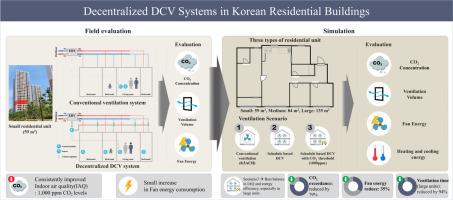Performance analysis of a decentralized DCV system for ventilation and energy use in Korean residential buildings
IF 7.6
1区 工程技术
Q1 CONSTRUCTION & BUILDING TECHNOLOGY
引用次数: 0
Abstract
This study investigates the applicability and performance of a decentralized demand-controlled ventilation (DCV) system in airtight South Korean residential buildings. In Korea, new residential buildings must install an energy recovery ventilator (ERV) to address both energy and indoor air quality, but pose from their conventional centralized ventilation. Unlike conventional centralized ventilation systems, which supply a uniform airflow regardless of occupancy, the decentralized DCV dynamically adjusts ventilation rates based on real-time occupancy status. A field experiment in a 59 m² apartment, using identical occupancy schedules, compared a baseline system with a decentralized DCV system. The DCV system maintained lower CO₂ concentrations, reducing time above 1000 ppm by up to 79 %, while increasing average fan energy consumption by only 9.2 %. EnergyPlus simulations were then performed for three representative apartment layouts (59 m², 84 m², and 135 m²) by applying three control scenarios under an identical occupancy schedule: (1) fixed-rate ventilation at 0.5 ACH, (2) schedule based DCV, and (3) schedule- and CO₂-threshold-based DCV. Scenario 3 achieved the most favorable balance between indoor air quality (IAQ) and energy efficiency, particularly in the 135 m² unit, where annual ventilation hours were reduced by over 94 % without exceeding the CO₂ threshold of 1000 ppm. These findings validate the effectiveness of decentralized DCV systems in mitigating unbalanced ventilation distribution and reducing energy waste in Korean residential buildings. The results provide empirical and simulation-based evidence for the feasibility of decentralized ventilation strategies in achieving both IAQ enhancement and energy conservation under realistic multi-zone occupancy conditions.

分散式DCV系统在韩国住宅通风和能源使用中的性能分析
本研究探讨分散式需求控制通风(DCV)系统在密闭韩国住宅建筑中的适用性和性能。在韩国,为了解决能源和室内空气质量问题,新建住宅必须安装能量回收通风机(ERV),但不能满足传统的集中通风。与传统的集中式通风系统不同,分散式DCV根据实时占用状态动态调整通风率,而集中式通风系统不考虑占用情况而提供均匀的气流。在一个59平方米的公寓中进行了现场实验,使用相同的占用时间表,将基线系统与分散的DCV系统进行了比较。DCV系统保持了较低的CO₂浓度,将超过1000ppm的时间减少了79%,而平均风扇能耗仅增加了9.2%。EnergyPlus随后对三种典型的公寓布局(59 m²,84 m²和135 m²)进行了模拟,在相同的占用计划下应用三种控制方案:(1)固定通风率0.5 ACH,(2)基于时间表的DCV,(3)基于时间表和CO₂阈值的DCV。方案3在室内空气质量(IAQ)和能源效率之间实现了最有利的平衡,特别是在135平方米的单元中,其年通风时间减少了94%以上,而不超过1000ppm的CO₂阈值。这些研究结果验证了分散式DCV系统在缓解韩国住宅建筑不平衡通风分布和减少能源浪费方面的有效性。研究结果为分散通风策略在实际多分区占用条件下实现室内空气质量提升和节能的可行性提供了实证和仿真证据。
本文章由计算机程序翻译,如有差异,请以英文原文为准。
求助全文
约1分钟内获得全文
求助全文
来源期刊

Building and Environment
工程技术-工程:环境
CiteScore
12.50
自引率
23.00%
发文量
1130
审稿时长
27 days
期刊介绍:
Building and Environment, an international journal, is dedicated to publishing original research papers, comprehensive review articles, editorials, and short communications in the fields of building science, urban physics, and human interaction with the indoor and outdoor built environment. The journal emphasizes innovative technologies and knowledge verified through measurement and analysis. It covers environmental performance across various spatial scales, from cities and communities to buildings and systems, fostering collaborative, multi-disciplinary research with broader significance.
 求助内容:
求助内容: 应助结果提醒方式:
应助结果提醒方式:


